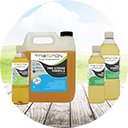Friction & Tribology
One third of the fuel is lost to friction
Friction is the force that resists the relative motion of solid surfaces, fluid layers and material elements sliding against each other. When surfaces in contact move relative to each other, the friction between them converts kinetic energy to thermal energy.

Friction is the force that resists the relative motion of solid surfaces, fluid layers and material elements sliding against each other. When surfaces in contact move relative to each other, the friction between them converts kinetic energy to thermal energy. Friction is a component of tribology, which is the science and engineering of interacting surfaces in relative motion. It includes the study and application of the principles of friction, lubrication and wear. Tribology is a branch where mechanical engineering meets materials science.
An international report (Tribology International 47, 2012) estimates that one third of the fuel consumption in a normal combustion engine is due to friction. Around half of this friction loss occurs in the engine and the transmission. In real terms, this means that the average car uses over 300 liters of fuel per year to overcome friction. Which equals more than 230 billion liters of fuel used worldwide.
Triboron Technology’s unique ability to reduce these friction losses would result in instant and sustainable fuel savings as well as lowered environmental impact by vehicles and machines powered by combustion engines.
Triboron Technology
A world-first discovery
Boron (B) is a chemical element with atomic number 5, and some boron compounds have extremely good lubrication properties. Triboron’s major scientific breakthrough is the ability to dissolve a low concentration of Boron into a clear, stable liquid. This is a world-first and the stability is a unique advantage that enables industrial distribution and use. The risk of agglomeration or sedimentation, which are downsides of similar products on the market, is eliminated. The dissolvent of our Boron compound is verified in a test performed by Chalmers University of Technology in 2014.
The instant impact of using Triboron technology can help to protect the environment. It is probably the most cost effective and fast technology to reduce climate emissions. Triboron technology can be used in fuels, oils and fats in a wide span of vehicles and machines, from power tools, scooters and cars to large stationary generators, trucks and ships. The technology interacts with the metal surfaces and forms a layer that reduces friction to a minimum even at EP Extreme Pressure.
Triboron can be added to fuels, oils and fats in a wide span of vehicles and machines, from power tools, scooters and cars to large stationary generators, trucks and ships. The technology interacts with the metal surfaces and forms a layer that reduces friction to a minimum with an EP (Extreme Pressure) function.
The layer doesn’t allow heat, moisture and acid precursors to interact with metallic parts. This prevents them from initiating or speeding up an oxidation process. A study of the surfaces using a Scanning Electron Microscopy (SEM) and energy-dispersive X-ray spectroscopy (EDS) shows that the boron forms a strong chemisorbed film that is not removed by washing. Only small amounts of Triboron refills are required to maintain its friction lowering capacity.
Research Partners

Triboron has established a partnership with the Tribomaterial group at Ångström Laboratory, Uppsala University covering friction and tribology research. The co-operation includes a support of a PhD position and the results of the first tests were presented at the 42nd Leeds-Lyon Symposium on Tribology in September 2015. They included a friction reduction up to 50% by using the Triboron Technology.
Patent
The Triboron Technology is patented in the United States (2015 & 2017), Australia (2016), Japan (2016) and Canada (2018), while patent applications are pending in the EU and India.
| Country | Patent. Nr | Valid to | Status |
| Australia | 2010250138 | 10/05/2030 | Granted 15/09/2016 |
| Australia | 2017246962 | 07/04/2037 | Granted 10/02/2022 |
| Australia | 2017350022 | 27/10/2037 | Granted 24/03/2022 |
| Brazil | PI1011566-8 | 10/05/2030 | Granted 11/02/2021 |
| Canada | 2761268 | 10/05/2030 | Granted 17/04/2018 |
| Canada | 3041781 | 27/10/2037 | Granted 08/11/2022 |
| India | 368874 | 27/10/2037 | Granted 09/06/2021 |
| Japan | 6042208 | 10/05/2030 | Granted 18/11/2016 |
| USA | 9222045 | 08/01/2033 | Granted 29/12/2015 |
| USA | 9688937 | 08/01/2033 | Granted 27/06/2017 |
| USA | 10954461 | 02/12/2037 | Granted 23/03/2021 |
The company’s technology research will likely also result in new patent applications.
Market Potential
Low-cost technology with enormous potential
Even if the transition to biofuels has started, fossil fuels will continue to play a major part in satisfying growing energy needs as the Earth’s population and urbanization grow. This means that the environmental performance of the Triboron technology has an enormous market potential for achieving international goals to reduce CO2 emissions with 75% by 2030.
Triboron Fuel formula works perfectly well with both fossil based (petrol & diesel) and biofuels (biofuels, FAME, methanol and ethanol) and can thereby enable a sustainable transformation from old to new transport alternatives.
Taking the growing environmental awareness into the equation, there is an enormous market potential for a simple technology that achieves a substantial large-scale CO2, CO and HC reduction to a very low investment.
A full-scale implementation of Triboron Technology in the global population of 1.3 billion vehicles as well as in machines for power generation and ships, would create an instant and sustainable impact, without any need for hardware replacements. The financial incentive from an operator and consumer perspective is also exceptionally positive. Every dollar spent on Triboron results in fuel savings worth approximately 3 dollars.




